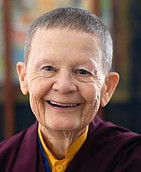Book – Start Where You Are (Summary)
Author – Pema Chödrön
Genre – Self-help Book
Published in – 2013
In the context of being kind to ourselves, Start Where You Are shows how our greatest asset is our vulnerability, which we so desperately protect.
With insight and humor, Pema Chödrön presents down-to-earth guidance on how to “start where we are, embracing rather than denying the painful aspects of our lives.
In our era, where we are often close to our feelings and withdraw from ourselves and others, this book helps us open up to ourselves and others.

About the Author –
Pema Chödrön is an American Tibetan Buddhist. She is an ordained nun, former Acharya of Shambhala Buddhism, and disciple of Chögyam Trungpa Rinpoche.
Chödrön has written several dozen books and audiobooks, including The Wisdom of No Escape When Things Fall Apart, and is the principal teacher at Gampo Abbey in Nova Scotia.
About the Book –
Start where you frame Pema’s teachings on compassion around fifty-nine traditional Tibetan Buddhist maxims or slogans, such as: “Always apply only a joyful state of mind,” “Don’t seek other’s pain as the limbs of your happiness,” and “Always meditate on whatever provokes resentment.”
Pema learned teachings in the book from Tibetan teacher Jamgon Kongtrul the Great. This teaching is Called the Lojong (Meaning “Mind Training) teachings, which also include a very supportive meditation practice called Tonglen and working with the seven points of mind training.
These practices show us how to accept ourselves, relate directly to suffering, and stop running away from the painful aspects of our lives. They show us how to work openheartedly with life just as it is.
A Few Keys Take Away From The Book
1) What Book Teaches –
- When we find that we are closing down to ourselves and others, here is instruction on how to open. When we find that we are holding back, here is education on giving.
- That unwanted rejection in ourselves and others can be seen and felt with honesty and compassion. This is teaching on how to be there for others without withdrawing.
2) No Escape, No Problem –
- Pema claims there is no need for self-improvement, and we are as good as we are. All the things we like and dislike about our life are our wealth. We are just one blink away from being fully awake. When we look at life this way, it fills us with hope.
- Only to the degree that we’ve gotten to know our pain, only to the degree that we’ve related with pain at all, will we be fearless enough, brave enough, and enough of a warrior to be willing to feel the pain of others.
3) Lojong Teachings –
- The basic teachings of Lojong are to embrace pain by holding on to our seat and going closer to it instead of running from it. Our instinct is to run from bad experiences and hold on to sound.
- Lojong teachings encourage readers to share generously with others instead of holding onto it and using unwanted experiences to awaken our hearts and let them soften us.
- Whether it’s pain or pleasure, through Lojong practice, we have a sense of letting our experience be as it is without trying to manipulate it, push it away, or grasp it.
- Labeling thoughts while MEDITATION is catching ourselves when we are distracted from breath and gently label it as “THINKING” and return to breath without judging, making drifting excellent or bad.

4) Pulling Out the Rug –
- Meditation isn’t about getting rid of thoughts — you’ll think forever. Nevertheless, if you follow the breath and label your thoughts, you learn to let things go. Beliefs of solidness, beliefs of emptiness, let it all go.
- If you contemplate meditation with lots of inhibition, you may consider starting small, like five minutes, and adding more time as you go along.
5) Poison As Medicine –
- In the Buddhist teachings, the messy stuff is called Klesha, which means poison. Boiling it all down to the most straightforward possible formula, there are three main poisons: passion, aggression, and ignorance.
- One object is what we find pleasant, another is what we find unpleasant, and a third is what we’re neutral about. If it’s delightful, it triggers craving; if it’s unpleasant, it triggers aversion; if it’s neutral, it triggers ignorance.
6) Start Where You Are –
- We must make friends with ourselves first before we get better with others. How we behave with sel is how we see the world. What we do for ourselves, we do for others, and vice-versa.
- You suffer if you have rage and righteously act it out and blame it all on others. The other people and the environment suffer also, but you suffer more because you’re being eaten up inside with rage, causing you to hate yourself more and more.
7) Tonglen Technique –
- Tonglem practice encourages breathing in negative feelings like jealousy, envy, pain, and sadness instead of sending them out. That’s another way of saying you don’t resist it. You surrender to yourself; you acknowledge who you are and honor yourself.
- By the same token, if you feel some sense of delight—connecting with something inspiring, opening, relieving, relaxing—you breathe it out, give it away, and send it out to everyone else. Please don’t hold it back. You let it flow.
8) Drive All Blames Into One –
- It’s said that everything has a beginning, middle, and end, but when we start blaming and talking to ourselves, things seem to have a beginning, a middle, and no end.
- Pema encourages readers to own their anger and other negative feeling. Let go of the narrative and go beyond blaming others.
- Try to be aware when you feel anger, drop the object that rose anger or any negative feeling. Be grateful for an opportunity to deal with this feeling and let it pass for good so it no longer affects you.
9) Be Grateful to Everyone –

- Being grateful to everyone is about making peace with the aspects of ourselves we have rejected. By doing that, we also make peace with the people we dislike. More to the point, being around people we dislike is often a catalyst for making friends with ourselves. Thus, “Be grateful to everyone.”
- Helping yourself or someone else involves opening up and being there; that’s how something happens between people. But it’s a continuous process.
10) Overcoming Resistance –
Resistance to unwanted circumstances can keep those circumstances alive and well for a long time.
Pema describes four ways to open the heart to our neurotic actions. Regret, refrain from remedial action, resolution.
- Regret – It’s about becoming aware of our misconduct or actions resulting from constant mindfulness. Without wallowing too much into it, we see neurosis as neurosis.
- Refrain – Without being too harsh on ourselves, we abstain from this behavior despite short-term fun and pleasure by picturing the long-term misery it causes.
- Remedial Action – Replacing lousy habits with good ones is much easier than keeping a vacuum. That is the way corrective action is. We replace bad habits with productive habits.
- Resolution – Again, without being too harsh, we abstain from indulging in our bad habits by constantly building good habits and remembering the consequences of bad habits.
11) Taking Responsibility for Your Actions –
- It means refraining from reacting to pleasure and pain, like repaying kindness and revenging the hurt.
- Don’t accuse others – Meaning stop gossiping about others. When someone irritates you, they trigger hidden pain that reminds you of someone you don’t like. Be grateful, process that feeling, go beyond the line, and deal with what bothered you.
- Don’t transfer the ox’s load to the cow – We often pass our load to others instead of dealing with it ourselves, and the thing is, it will keep coming back to us until we learn the lesson from it, which it had to teach us.
- Don’t seek others’ pain as the limbs of your happiness – This one is prevalent, and we must avoid it. We feel happy when people who mistreat us suffer in some way and resent when they prosper.
12) Communication From the Heart –
- Instead of taking resentment as an obstacle, please take it as a reminder. Feeling irritated, restless, afraid, and hopeless is a reminder to listen more carefully.
- The slogan “Keep the three inseparable” says that your actions, speech, and thoughts should be inseparable from this yearning to communicate from the heart.
I have also created a video of a few quotes from the book – I hope you like it. Please subscribe to my YouTube Channel – Myread4change.
Conclusion –
Start Where You Are is a fantastic book that will help you open your heart and give you enough to work on your spiritual journey. It will be worth your time and attention.
If you like this book, you may also like The Power of Now and The Power of Awareness.
I hope this book summary helped you in some ways.
So Start Where You Are.
With Love,
Muzammil


It’s such an excellent book.
Thanks for helping out, good information.
Thanks for sharing, this is a fantastic blog article. Really looking forward to reading more. Much obliged.
This is one excellent article post. I am really looking forward to reading more. Awesome.
Good post and straight to the point. I am not sure if this is really the best place to ask but do you people have any ideea where to get some professional writers? Thank you 🙂
I discovered your blog site on google and check a few of your early posts. Continue to keep up the very good operate. I just additional up your RSS feed to my MSN News Reader. Seeking forward to reading more from you later on!…
I went over this website and I think you have a lot of great information, saved to fav (:.
Looking forward to reading more. Great blog.Much thanks again. Fantastic.
Thanks so much for the blog article.Really looking forward to read more. Really Great.
I like reading through and I conceive this website got some truly useful stuff on it! .